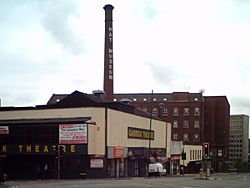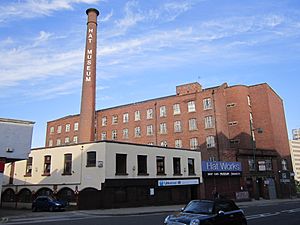Hat Works facts for kids

Hat Works, Stockport
|
|
| Lua error in Module:Location_map at line 420: attempt to index field 'wikibase' (a nil value). | |
| Cotton | |
|---|---|
| Alternative names | Wellington Mill |
| Spinning Mill | |
| Structural system | Brick and cast iron fireproof mill |
| Location | Stockport, Greater Manchester, England |
| Owner | Thomas Marsland |
| Current tenants | The Hat Works Museum, residential |
| Construction | |
| Built | 1828 |
| Renovated |
|
| Floor count | 7 |
|
Listed Building – Grade II
|
|
| Official name: Wellington Mill | |
| Designated: | 10 March 1975 |
| Reference #: | 1356847 |
The Hat Works is a cool museum in Stockport, Greater Manchester, England. It first opened its doors in the year 2000. Before that, smaller collections of hat-making tools were shown in other local museums.
The building itself is called Wellington Mill. It was built a long time ago, between 1830 and 1831. It was first a special kind of cotton spinning mill that was designed to be safe from fires. Later, in the 1890s, it became a factory where hats were made. Today, it's a Grade II listed building, which means it's an important historical place. You can find it on the A6 road, between the town centre and Stockport railway station.
Contents
Stockport's Textile Story
Stockport was a very important place for making textiles in the United Kingdom. First, it was known for silk throwing, which is the process of twisting silk threads.
From Silk to Cotton
In the early 1700s, England couldn't make silk thread good enough for weaving. They had to import it from Italy, where machines powered by water did the spinning. Around 1717, a man named John Lombe went to Italy and secretly copied the machine designs. He came back, got a special permission (a patent), and started making silk in Derby.
When Lombe tried to keep his patent in 1732, silk makers from other towns, including Stockport, asked the government not to let him. They succeeded, and Lombe was paid off. In 1732, Stockport opened its first silk mill. This was the first water-powered textile mill in the north-west of England! More mills opened on local rivers.
Silk weaving grew a lot, and by 1769, about 2,000 people worked in the silk industry. Sometimes, the business was great, and other times it was tough, maybe because of cheaper silk from other countries. This up-and-down cycle happened often in the textile industry.
The Rise of Cotton Mills
On July 21, 1784, Samuel Oldknow came to Stockport. He bought a house and a warehouse. He gave out cotton threads to local weavers who worked from home. They would weave the cloth and bring it back to him. This was called the Putting-out system. It was common for weaving even after factories became normal for spinning.
Stockport was a great place for cotton factories because it had good water power and many people, especially women and children, who already knew how to work in textile mills. The first cotton mill in Stockport was Warren's mill. It used a water wheel powered by the River Goyt. Other mills also opened, using water from the Tame.
Hat Making Becomes Big
Hatmaking started in the Stockport area as early as the 1500s. In the early 1800s, more and more hat makers appeared, and the area became known for making high-quality hats. By the late 1800s, hat making changed from being done by hand to using machines. It became one of the biggest jobs in Stockport.
Stockport, along with a nearby town called Denton, was the main place in the country for making hats. Other businesses that helped hat making, like those making hat blocks or trimmings, also grew. However, the First World War made it hard to sell hats overseas. This hurt Stockport's hat industry.
Even so, in 1932, over 3,000 people still worked in hat making. It was the third largest employer in Stockport after textiles and engineering. But then, in the 1930s, fewer people wanted hats, and cheaper hats made from wool in other places, like Luton, became popular. This caused the hat industry in Stockport to shrink a lot.
History of Wellington Mill
Wellington Mill was built in 1830 by Thomas Marsland. He was a very rich man who made his money from a large fabric printing business in Stockport. His father, John Marsland, started a dyeing business in the 1780s. Thomas continued the family business, printing colorful patterns on fabric, especially a type called calico printing. His business was one of the biggest in Europe.
Building the Mill
In 1826, a new main road (now called Wellington Road) was opened. Thomas Marsland bought a large piece of land next to his printing works and the new road to build the mill.
When the mill was finished, Thomas Marsland worked there with two of his sons-in-law, Richard Hole and Alexander Lingard. Later, Thomas left the business, and another son-in-law, William Courteney Cruttenden, joined. Over the years, the ownership changed a few times within the family. By 1870, John Marsland Lingard, Alexander's son, was the only owner.
In 1872, he rented the building to John and George Walthew, a company that spun and twisted cotton thread. Then, in 1895, the mill was sold to Ward Brothers, who were hat makers.
Mill Changes Over Time
A tall, round chimney, about 200 feet (61 m) high, was added to the mill in 1860. Ward Brothers, the hat makers, used part of the building from 1895 until the 1930s.
The Mill Building's Design
Wellington Mill was part of a bigger group of buildings owned by the Marsland family. The building you see today is a 7-and-a-half-story mill that was built to be fireproof. It was constructed between 1828 and 1831. It has a round stair tower sticking out from its eastern side.
How it was Built
The main part of the building is about 135 feet (41 m) long and 42 feet (13 m) wide. It was built with a cast-iron frame, which made it very strong and fire-resistant. Two cast-iron pillars supported a cast-iron beam that went across the mill. Brick arches (vaults) were built from these beams, creating a strong floor for the next level. The space above these arches was filled with sand, and then wooden floors were laid on top. This design helped stop fires from spreading.
The ground floor was about 9 feet 6 inches (2.90 m) high, and most other floors were about 9 feet (2.7 m) high. From the outside, you can see large windows on each floor. The roof was made of blue Welsh slate.
Powering the Mill
The original engine houses, where the power machines were kept, are no longer there. Records show that in 1830, the mill had a 65-horsepower beam engine. This was a large steam engine that helped power the machinery. It was replaced by an even bigger engine in 1835.
The tall, round brick chimney, added in 1860, was about 200 feet (61 m) tall. It was used by four large Lancashire boilers, which made the steam for the engine.
Power was sent through the mill using a system of shafts and gears. A main shaft went up through all the floors, and then other shafts carried the power to the different machines on each level.
Even though we don't have exact records of the spinning machines used, the mill's width suggests it was built for "self-acting spinning mules." These were advanced machines patented in 1825 that could spin cotton thread almost by themselves. Later, when John and George Walthew took over, they used "throstles," another type of spinning machine.
Ward Brothers Hat Makers
Ward Brothers moved into Wellington Mill in 1895 and stayed there until the 1930s. Sarah Ward had started a hat business in 1848. They were experts at finishing and decorating hats. They bought the basic wool hat shapes from other places like Denton and Stockport. This meant they didn't need the "wet-end sheds" where hats were first shaped.
They didn't have to change the cotton mill much, but they did add a central staircase and a new front to the eastern side of the building. Ward Brothers made many kinds of hats, including stiff felt hats, soft felt hats, men's straw hats, tweed caps, and hats for children.
The Hat Works Museum Today
By 1966, many of the big hat makers in the area joined together to form a company called Associated British Hat Manufacturers. Eventually, only two factories were left: Christy & Co and Wilson's. Wilson's factory closed in 1980, and Christy's factory closed in 1997. This marked the end of over 400 years of hat making in the Stockport area.
The Hat Works museum was created to remember and celebrate this important history. It is the only museum in the UK completely dedicated to hat making!
Images for kids
See also
- Listed buildings in Stockport
- List of mills in Stockport






